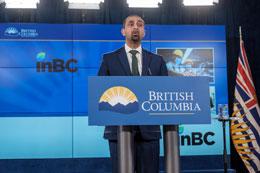BC needs one million new workers in 10 years

By Mata Press Service
British Columbia’s workforce will be required to build new skills and knowledge to keep pace with the 1,004,000 job openings forecast through to 2031, states the province’s latest Labour Market Outlook (LMO).
Immigrants and temporary foreign workers are not expected to be enough to meet demand for labour in the next 10 years, as retirements outpace population growth, said the report.
Of the total, 63% will replace people who are leaving the workforce permanently, such as retirees. The remaining 37% will be new jobs created by economic growth and COVID-19 pandemic recovery.
The LMO is a 10-year forecast that helps governments and businesses guide resources to support the future workforce and it gives British Columbians up-to-date information so they can make decisions about their future career paths. Nearly 80% of these future job openings will require some level of post-secondary education or training.
The largest number of job openings are expected in the healthcare, social assistance and education industries. Many of these openings will provide services such as early childhood education, counselling, child protection and community housing and food services. Science and technology jobs will also be in high demand with 111,000 job openings projected and 85,000 job openings expected in skilled trades, which will offer careers ranging from cooks and automotive service technicians to construction workers and hairstylists.
“Our government remains committed to supporting people and communities now and into the future. Despite the challenges of the past two years, there are new opportunities ahead for people looking for good-paying careers,” said Anne Kang, Minister of Advanced Education and Skills Training.
“We’re working to break down barriers and expand affordable post-secondary and skills training opportunities so that with the right supports, the people of British Columbia can benefit from the good jobs this report projects. With more than one million forecasted jobs, we’re laying the foundation for future prosperity and we will not leave anyone behind. Diversity will be our strength as we continue to build an innovative, sustainable and inclusive economy with good, secure jobs for people in B.C.”
A new interactive career transition tool is available in multiple languages at WorkBC.ca. Using this and other accessible online resources, students and job seekers can find in-demand jobs, employers can be guided in their business planning and educators can ensure programs provide British Columbians with the skills to succeed in the province’s growing economy.
“B.C. continues to lead Canada’s economic recovery with more than 100,000 jobs added in 2021,” said Ravi Kahlon, Minister of Jobs, Economic Recovery and Innovation.
“I’ve heard from business leaders, First Nations, labour groups and non-profits throughout the province that B.C.’s competitive advantage is its people. That’s why our upcoming economic plan will put forward a generational commitment to attract, develop and retain talent to support the jobs of the future. By continuing to invest in people, we will build a stronger, more inclusive workforce and prepare British Columbians to compete on a global stage.”
Quick Facts:
• B.C. added more than 100,000 jobs throughout the province in 2021, and B.C.’s unemployment rate stands at 5.3%.
• Five industries will account for approximately half of all projected job openings, including health care and social assistance; professional, scientific and technical services; retail trade; construction; and accommodation and food services.
• The tech sector continues to see rapid growth. For example, since the 2019 LMO, the computer systems design sector grew 39% in B.C. and is expected to grow at an average annual rate of 4.8% over the next 10 years.
• People 29 or younger entering the workforce for the first time will be the largest source of B.C.’s new labour supply. They will fill approximately 48,000 job openings or 48% of the total job openings each year for the next 10 years.
• New immigrants will fill 34%, while workers coming from other parts of Canada will fill 8% of the jobs.






